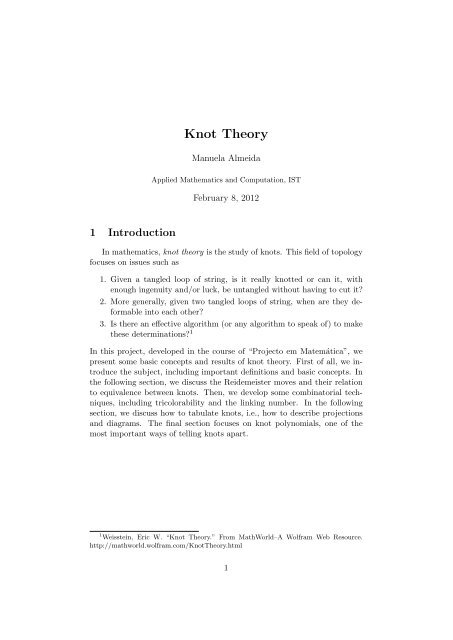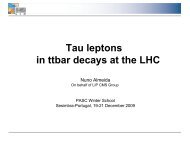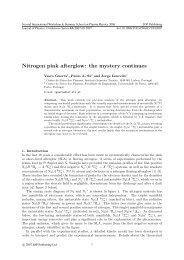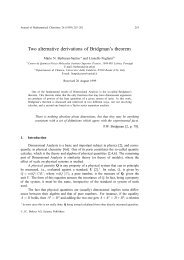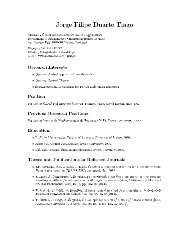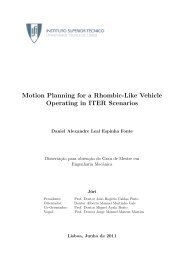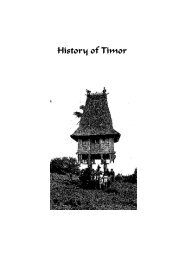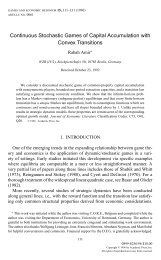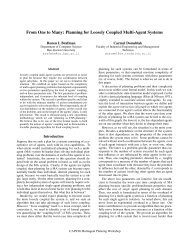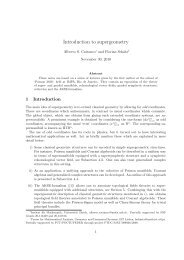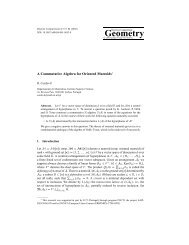Knot Theory
Knot Theory
Knot Theory
Create successful ePaper yourself
Turn your PDF publications into a flip-book with our unique Google optimized e-Paper software.
<strong>Knot</strong> <strong>Theory</strong><br />
Manuela Almeida<br />
Applied Mathematics and Computation, IST<br />
February 8, 2012<br />
1 Introduction<br />
In mathematics, knot theory is the study of knots. This field of topology<br />
focuses on issues such as<br />
1. Given a tangled loop of string, is it really knotted or can it, with<br />
enough ingenuity and/or luck, be untangled without having to cut it?<br />
2. More generally, given two tangled loops of string, when are they deformable<br />
into each other?<br />
3. Is there an effective algorithm (or any algorithm to speak of) to make<br />
these determinations? 1<br />
In this project, developed in the course of “Projecto em Matemática”, we<br />
present some basic concepts and results of knot theory. First of all, we introduce<br />
the subject, including important definitions and basic concepts. In<br />
the following section, we discuss the Reidemeister moves and their relation<br />
to equivalence between knots. Then, we develop some combinatorial techniques,<br />
including tricolorability and the linking number. In the following<br />
section, we discuss how to tabulate knots, i.e., how to describe projections<br />
and diagrams. The final section focuses on knot polynomials, one of the<br />
most important ways of telling knots apart.<br />
1 Weisstein, Eric W. “<strong>Knot</strong> <strong>Theory</strong>.” From MathWorld–A Wolfram Web Resource.<br />
http://mathworld.wolfram.com/<strong>Knot</strong><strong>Theory</strong>.html<br />
1
2 BASIC CONCEPTS 2<br />
2 Basic Concepts<br />
2.1 Definition of <strong>Knot</strong><br />
A knot is a closed non-self-intersecting curve embedded in R 3 . In other<br />
words,<br />
Definition 1. A knot is a simple closed polygonal curve in R 3 , i.e., it is<br />
the union of the segments [p 1 ,p 2 ],[p 2 ,p 3 ],. . . ,[p n−1 ,p n ] of an ordered set of<br />
distinct points (p 1 ,p 2 , ..., p n ) in which each segment intersects exactly two<br />
others.<br />
2.2 Projection and diagram of a knot<br />
In order to study knots, it is useful to consider projections of the knot on<br />
planes P ⊂ R 3 .<br />
Definition 2. The image of a knot K under a projection map is called the<br />
projection of K.<br />
In order to avoid losses of information, one should use regular projections,<br />
i.e.,<br />
Definition 3. A knot projection is called a regular projection if<br />
1. no three points on the knot project to the same point, and<br />
2. no vertex projects to the same point as any other point in the knot.<br />
Figure 2.1: A regular projection and a non-regular projection of the same knot.<br />
There is another loss of information when the projection map is applied:<br />
we can no longer see which portions of the knot pass over others parts.<br />
A diagram of a knot is the drawing of its regular projection in which are<br />
left gaps to remedy this fault. We call the arcs of this diagram edges and<br />
the points that correspond to two double points in the projection crossings.<br />
When we “travel” around the knot, if a portion of a knot passes over another<br />
part, we call it an overcrossing and if, on the other hand, a portion passes
2 BASIC CONCEPTS 3<br />
under another, we call it an undercrossing. The diagram of a knot will be<br />
drawn as a smooth curve. 2<br />
Figure 2.2: The unknot, with no crossings, and the figure-eight knot, with four<br />
crossings.<br />
Definition 4. An oriented knot consists of a knot and an ordering of its<br />
vertices. Two orderings are called equivalent if they differ by a cyclic permutation.<br />
Figure 2.3: The diagram of a trefoil’s projection and its drawing as a polygonal<br />
curve.<br />
Definition 5. An alternating knot is a knot with a diagram that has crossings<br />
alternating between over and under, fixed an orientation.<br />
Sometimes we will use in this paper the Alexander-Briggs notation. This<br />
consists of writing the number of crossings of a knot with a subscript to<br />
denote its archiving number within the class of knots with the given number<br />
of crossings. This numbering scheme can be found in the paper “On types<br />
2 It is our intuitive way of thinking about knots.
2 BASIC CONCEPTS 4<br />
of knotted curve”, Annals of Mathematics, 28:562–586, 1926-1927 by James<br />
W. Alexander and G. B. Briggs. For instance, the trefoil will de denoted by<br />
3 1 .<br />
2.3 Links<br />
In the study of knots, it is useful to consider objects where the number<br />
of loops knotted bigger than one. Taking this into account, it’s necessary to<br />
introduce the notion of link.<br />
Definition 6. A link is a collection of disjoint knots.<br />
A link is called splittable if it can be deformed so that its components lie<br />
in different sides of a plane in R 3 . It is not easy to tell if a link is splittable<br />
but it is quite simple to distinguish some links by considering their number<br />
of components: if L has a different number of components than L ′ , they are<br />
not equivalent.<br />
Figure 2.4: A link with two components (two unknots) and the Whitehead link.<br />
2.4 Deformations<br />
It is necessary to define more rigorously the notion of equivalence between<br />
two knots. First of all, it is necessary to define the notion of elementary<br />
deformations.<br />
Definition 7. A knot J is called an elementary deformation of the knot K<br />
if one is determined by a sequence of points (p 1 ,p 2 , . . . , p n ) and the other is<br />
determined by the sequence (p 0 ,p 1 ,p 2 , . . . , p n ), where<br />
1. p 0 is a point which is not collinear with p 1 and p n , and<br />
2. the triangle spanned by (p 0 ,p 1 ,p n ) intersects the knot determined by<br />
(p 1 ,p 2 , . . . , p n ) only in the segment [p 1 ,p n ].<br />
It must be noted that the second condition of this definition assures that<br />
the knot does not cross itself as it is deformed.
2 BASIC CONCEPTS 5<br />
Figure 2.5: Illustration of an elementary deformation.<br />
It is now possible to define equivalence:<br />
Definition 8. Two knots K and J are called equivalent if there is a sequence<br />
of knots K = K 0 ,K 1 , . . . , K n = J, with each K i+1 an elementary<br />
deformation of K i .<br />
At this point we can define more precisely the objective of knot theory:<br />
the study of equivalence classes of knots. For instance, proving the existence<br />
of a non-trivial knot is the same as proving that there exists a knot not<br />
contained in the equivalence class of the unknot. More generally, proving<br />
that two knots are different is the same as proving that they lie in different<br />
equivalence classes.<br />
Theorem 1. If two knots K and J have identical diagrams, then they are<br />
equivalent.<br />
Proof. Let’s assume that the knot K is represented by the ordered set<br />
(p 1 , . . . , p n ) and the knot J is represented by the ordered set (q 1 , . . . , q n ).<br />
We may introduce new vertices, if necessary, in order to ensure that both<br />
knots have the same number of vertices. Therefore, since they have identical<br />
diagrams, we can perform a sequence of elementary deformations that<br />
transform (p 1 , . . . , p n ) in (q 1 , . . . , q n ), as illustrated bellow.<br />
Figure 2.6
3 REIDEMEISTER MOVES 6<br />
Figure 2.7: In this case it was necessary to introduce new vertices.<br />
3 Reidemeister moves<br />
One of the fundamental results of knot theory characterizes equivalence<br />
between knots in terms of their diagrams.
3 REIDEMEISTER MOVES 7<br />
Figure 3.1: Reidemeister moves type I, II and III.<br />
These operations can be performed on a knot’s diagram without changing<br />
the knot itself.<br />
Theorem 2. Two knots or links are equivalent if and only if their diagrams<br />
are related by a sequence of Reidemeister moves.<br />
Proof. Let K and J be equivalent knots. Then, by definition 8, there is a<br />
sequence of knots K = K 0 ,K 1 , . . . , K n = J, with each K i+1 an elementary<br />
deformation of K i . One can pick a projection which is regular for all the K i .<br />
Then, without loss of generality, this proof can be reduced to the case of<br />
knots related by a single elementary deformation. Resorting, if necessary, to<br />
a small rotation we can ensure that the triangle along which the elementary<br />
deformation is performed is projected to a triangle in the plane (figure 2.5).<br />
This last triangle may contain many parts of the diagram knot, but it can<br />
be subdivided into smaller triangles so that each contains a single crossing<br />
of the diagram or a segment. In other words, we can view this elementary<br />
deformation as the composition of a series of other elementary deformations<br />
performed on smaller triangles. It is now necessary to check that only Reidemeister<br />
moves were applied between the two diagrams:<br />
This is the case when the intersection with the deformation triangle is a<br />
segment and this segment is adjacent to the segments being deformed.
3 REIDEMEISTER MOVES 8<br />
Figure 3.2: Reidemeister move type I. If we change the crossing, the process is<br />
similiar.<br />
This is the case when the intersection with the deformation triangle is a<br />
segment not adjacent to the segments being deformed.<br />
Figure 3.3: Reidemeister move type II. If we change the crossings, the process is<br />
similiar.<br />
This is the case when the intersection with the triangle is a crossing.
3 REIDEMEISTER MOVES 9<br />
Figure 3.4: Reidemeister move type III. If we change the crossings, the process is<br />
similiar.<br />
When proving the equivalence of two knot diagrams one often uses planar<br />
isotopies. Informally, these are the deformations of a knot’s diagram<br />
to another by stretching and bending the segments of the projection (never<br />
crossing other segments). Formally, they correspond to sequences of elementary<br />
deformations where the projection of the deformation triangle does not<br />
intersect the rest of the knot diagram.<br />
Example 1 (Two diagrams representing the trefoil knot, and a sequence of<br />
Reidemeister moves relating them). 3<br />
3 Exercise 1.10 of The <strong>Knot</strong> Book.
4 COMBINATORIAL TECHNIQUES 10<br />
Figure 3.5: The first knot in this image is equivalent to the trefoil knot.<br />
4 Combinatorial Techniques<br />
4.1 Tricolorability<br />
A fundamental question in knot theory is how to distinguish knots. In this<br />
section, we present very simple combinatorial techniques that sometimes allow<br />
us to achieve this goal.
4 COMBINATORIAL TECHNIQUES 11<br />
The first combinatorial technique that we present is the method of tricolorability.<br />
Definition 9. A diagram of a knot or a link is tricolorable if each of the<br />
arcs can be colored in one of three different colors, so that at each crossing,<br />
either three different colors come together or all the segments have the same<br />
color.<br />
Once we prove that this property depends only on the equivalence classe<br />
of the knot, it is possible to say, for instance, that the trefoil is different<br />
from the unknot. The unknot, according to the previous definition, is not<br />
tricolorable: it is only possible to color the trivial knot with one color. On<br />
the other hand, as seen in the figure 4.2, the trefoil is tricolorable.<br />
Figure 4.1: The trefoil knot is tricolorable.<br />
Example 2. 4<br />
Figure 4.2: The knot 7 4 is tricolorable.<br />
Theorem 3. If a diagram of a knot K is tricolorable, then every diagram<br />
of K is tricolorable.<br />
4 Exercise 1.22 of The <strong>Knot</strong> Book.
4 COMBINATORIAL TECHNIQUES 12<br />
Proof. To prove this last result it is only necessary to show that performing<br />
a Reidemeister move - RM - on a tricolorable diagram doesn’t change its<br />
tricolorability.<br />
RM type I.<br />
(→) In this case, the original arc has one color. When the type I move is<br />
applied in this direction, a crossing is added and, as a result, there are now<br />
two arcs. Leaving these two arcs with the same color preserves tricolorability.<br />
(←) In this case, the two arcs have the same color. When the move is applied,<br />
the result is just one arc so there is nothing to check. The diagram is<br />
still tricolorable.<br />
RM type II.<br />
(→) In this case, there are two options: either the two original arcs have<br />
the same color and when the type II move is applied we can just leave them<br />
with that color, or the two original arcs have two different colors, when the<br />
type II move is applied we color the new arc with the third color, as in figure<br />
4.3.<br />
Figure 4.3: The colors chosen for this example are illustrative only.<br />
(←) In this case, when type II move is performed, we obtain two arcs<br />
that do not intersect. If there were only one color, then the two new arcs<br />
will preserve that color. If there were three different colors then the color<br />
of the segments on the left are the same. Therefore, the new arc on the left<br />
will preserve that color and the arc on the right will preserve the color of<br />
the segment in the middle. The diagram is still tricolorable.<br />
RM type III. In this case, it is necessary to check five different cases:
4 COMBINATORIAL TECHNIQUES 13<br />
Figure 4.4: All this five scenarios prove that the resulting diagram after performing<br />
type III move is still tricolorable.<br />
4.2 Linking number<br />
Given an oriented link with two components, say W , we can calculate its<br />
linking number in order to “measure” how linked up this components are.<br />
In order to do this, we assign signs as follow: +1 to right-handed crossings<br />
and -1 to left-handed crossings.<br />
Figure 4.5: Right-handed crossing and left-handed crossing.
4 COMBINATORIAL TECHNIQUES 14<br />
Definition 10. The linking number of W is defined to be the sum of the<br />
signs of the crossings where the two components meet, divided by 2.<br />
Example 3. 5<br />
Figure 4.6: With the orientations on the left, this link has linking number +1.<br />
Reversing the orientation of one of the components one obtains the<br />
linking number -1.<br />
The linking number is an invariant of the oriented link. This is, fixed<br />
an orientation, the linking number is unchanged by ambient isotopy - the<br />
movement of the knot through the three-dimensional space without letting<br />
it pass through itself. Therefore, if two links have distinct linking number<br />
they must different. However, we cannot tell apart two links with the same<br />
linking number. For example, the linking number of the Whitehead link is<br />
0, so it is the same as the linking number of the trivial link with two components.<br />
However, it can be shown that the Whitehead link is not trivial.<br />
In order to prove that if two links have distinct linking number they must be<br />
different it is only necessary to show that performing a Reidemeister move<br />
won’t change this number.<br />
RM type I. This Reidemeister move doesn’t affect in any way the linking<br />
number because the crossing that is added or removed is with the arc-itself.<br />
RM type II.<br />
5 Exercise 1.15 of The <strong>Knot</strong> Book.<br />
Figure 4.7
5 TABULATING KNOTS 15<br />
(→) When this move is applied, a +1 and a -1 are added. So, the linking<br />
number is not affected.<br />
(←) When this move is applied, a +1 and a -1 are subtracted. So, as<br />
before, the linking number is not affected.<br />
RM type III. Performing this Reidemeister move in any direction doesn’t<br />
change the number of +1s and -1s. So, the linking number isn’t affected.<br />
Figure 4.8<br />
In figure 4.8, we assume that the horizontal segment belongs to a different<br />
component than the others. The other cases are similar.<br />
It must be noted that if the orientation of one component is changed,<br />
the linking number of the knot is multiplied by -1 (as seen in example 3).<br />
5 Tabulating <strong>Knot</strong>s<br />
5.1 The Dowker Notation for <strong>Knot</strong>s<br />
The Dowker notation is one way of describing a knot’s projection. This<br />
method, in the case of alternating knots, can be described by the following<br />
algorithm:<br />
1. Choose an orientation;<br />
2. Choose an arbitrary crossing and label it 1;<br />
3. Follow the undergoing strand to the next crossing and label it 2;<br />
4. Continue to follow the same strand and label consecutively the crossings<br />
until each one of them has two numbers;<br />
5. Each crossing will have an even and an odd number (we will explain<br />
the reason why later) in a total of 2n numbers; write in a row the<br />
odd numbers 1 3 . . . 2n − 1 and underneath it the corresponding even<br />
numbers.
5 TABULATING KNOTS 16<br />
The row with the even numbers is the knot’s Dowker representation.<br />
Example 4. 6<br />
Figure 5.1: A sequence of integers that represents 6 2 .<br />
Figure 5.2: Two sequences of integers that represent 6 3 .<br />
A set consisting of pairs of numbers is drawable if it fulfills the following<br />
condition:<br />
Any two loops defined by a given interval must either share one or more<br />
segments or intersect in an even number of points, not including the initial<br />
and the end point.<br />
It was noted above that every crossing has one even and one odd number.<br />
7 If it were not the case, i.e., if i and j were both even or both odd, then<br />
6 Exercise 2.3 of The <strong>Knot</strong> Book.<br />
7 Exercise 2.2 of The <strong>Knot</strong> Book.
5 TABULATING KNOTS 17<br />
we would have two loops, namely i, i +1, . . . , j − 1,j and j, j +1, . . . , 2n −<br />
1, 2n, 1, . . . , i that do not share any segment but intersect in an even number<br />
of points including the initial and end points, in contradiction with the<br />
condition above.<br />
Example 5. 8<br />
Figure 5.3: The alternating knot corresponding to the sequence 10 12 8 14 16 4<br />
2 6.<br />
We can give an upper bound on the number of possible alternating knot<br />
projections with, for example, seven crossings. 9 This is given by counting<br />
how many sequences of integers 2 4 6 8 10 12 14 there are: 7!.<br />
The Dowker notation can be generalized to non-alternating knots. The<br />
procedure is the same as for alternating knots with the difference that, if a<br />
crossing is assigned an even integer on the understrand that number is given<br />
a negative sign. Otherwise, the even integer is left with a positive sign.<br />
8 Exercise 2.5 of The <strong>Knot</strong> Book.<br />
9 Exercise 2.7 of The <strong>Knot</strong> Book.
5 TABULATING KNOTS 18<br />
Figure 5.4: This non-alternating knot has the sequence 6 -14 16 -12 2 -4 -8 10.<br />
We can now calculate n upper bound on the number of alternating and<br />
non-alternating knots with seven crossing. As it was seen before, there are<br />
7! sequences corresponding to the alternating knots. As each even number<br />
may have a positive or a negative sign, there are 7!2 7 possibilities. It must be<br />
noted that, in fact, there aren’t these many knots: there are sequences that<br />
represent the same knot and sequences which are not possible, as discussed<br />
above.<br />
5.2 Conway’s Notation<br />
Definition 11. A tangle in a knot (or link) projection is a region in the<br />
projection plane surrounded by a circle such that the knot (or link) crosses<br />
the circle exactly four times.<br />
The equivalence between tangles can be defined by<br />
Definition 12. Two tangles are said to be equivalent if they are related by<br />
a sequence of Reidemeister moves taking place in the interior of the circle.<br />
Figure 5.5: Tangles.
5 TABULATING KNOTS 19<br />
Figure 5.6: The ∞ tangle and the 0 tangle.<br />
An n-tangle is a tangle with n twists in which the overstrand has always<br />
positive slope (if we think of it as a small line segment in the plane). In the<br />
same way, in an −n-tangle, the overstrand always has negative slope.<br />
Figure 5.7: 3-tangle and −3-tangle<br />
The multiplication of two tangles, say T 1 and T 2 , if defined as illustrated<br />
in figure 5.8 10 : first T 1 is reflected across its NW to SE diagonal line and<br />
then it is “glued” to T 2 . This operation is not associative.<br />
Figure 5.8<br />
The operation of addition of tangles is defined as illustrated in 5.9 11<br />
10 http : //en.wikipedia.org/wiki/F ile : T angle Operations.svg<br />
11 http : //en.wikipedia.org/wiki/F ile : T angle Operations.svg
5 TABULATING KNOTS 20<br />
Figure 5.9<br />
A rational tangle is a multiplication of ±n-tangles in the order ((((t 1 t 2 )t 3 )t 4 )...t n ).<br />
The 0 tangle is an additive identity for tangles 12 . There is, also, a left<br />
multiplicative identity which is the ∞ tangle. However, there isn’t a right<br />
multiplicative identity. 13 We can show this by contradiction: Suppose that<br />
there exists a right multiplicative identity, say I r . So, the product of the<br />
0 tangle with I r would have to be 0. By definition of multiplication, the<br />
first thing to do is to reflect the 0 tangle across its NW to SE diagonal.<br />
The result is the ∞ tangle. Now we have to “glue” this two tangles. It is<br />
impossible to obtain as a result the 0 tangle as we can see in figure 5.10.<br />
Figure 5.10<br />
A rational tangle t 1 t 2 . . . t n can be assigned the following continued fraction<br />
t n +<br />
t n−1 +<br />
1<br />
1<br />
... + 1<br />
t 2 + 1 t 1<br />
12 Exercise 2.21 of The <strong>Knot</strong> Book.<br />
13 Exercise 2.22 of The <strong>Knot</strong> Book.
5 TABULATING KNOTS 21<br />
Theorem 4. Two tangles in Conway’s notation are equivalent if and only<br />
if the rational number obtained from the corresponding continued fraction is<br />
the same.<br />
Example 6. 14 a)<br />
Figure 5.11: -2 -2 -2 -2 -2<br />
The respective continuous fraction: −2+<br />
−2+<br />
1<br />
−2+<br />
1<br />
1<br />
−2+ 1<br />
−2<br />
= − 29<br />
12<br />
b)<br />
Figure 5.12: 2 -3 2<br />
The respective continuous fraction: 2 +<br />
1<br />
−3+ 1 2<br />
= 8 5<br />
c)<br />
Figure 5.13: -4 1 2<br />
The respective continuous fraction: 2 +<br />
14 Exercise 2.13 of The <strong>Knot</strong> Book.<br />
1<br />
1+ 1<br />
−4<br />
= 10 3
6 POLYNOMIALS 22<br />
d)<br />
Figure 5.14: 1 1 1 1 1<br />
1<br />
The respective continuous fraction: 1 +<br />
1<br />
1+<br />
1+ 1<br />
= 8 5<br />
1+ 1 1<br />
We can conclude, by theorem 4, that tangles b) and d) are the same.<br />
An algebraic tangle is a tangle obtained by the operations of addition<br />
and multiplication on rational tangles. For instance, the knot 8 5 can be<br />
written as (3 × 0) + (3 × 0) + (2 × 0).<br />
Figure 5.15: 8 5 has Conway notation 3, 3, 2.<br />
For knots with few crossings, we can describe them in this notation.<br />
However, Conway’s notation is not necessarily valid to every knot.<br />
6 Polynomials<br />
The polynomials that we will present in this section are Laurent polynomials,<br />
which can have both positive and negative powers.<br />
We will describe this polynomials in terms of skein relations, i.e.,<br />
Definition 13. A skein relation is an equation that relates the polynomial<br />
of a knot (or link) to the polynomial of knots (or links) obtained by changing<br />
the crossings in a projection of the original link.
6 POLYNOMIALS 23<br />
One can prove that the value of the polynomial obtained by applying<br />
the skein relation is independent of the choice of the order of the crossings.<br />
A resolving tree is the process of repeatedly choosing a crossing, applying<br />
the skein relations and obtain two simpler links.<br />
Example 7 (The resolving tree of the trefoil).<br />
Figure 6.1<br />
6.1 The Bracket Polynomial and the Jones Polynomial<br />
The rules to calculate the bracket polynomial of L, < L > ∈ Z[A, A −1 ]:<br />
• Rule 1: =1<br />
• Rule 2:<br />
• Rule 3: =(−A 2 − A −2 ) < L ><br />
Example 8 (The bracket polynomial of the trivial link of n components.).<br />
15<br />
By rule 3, we have<br />
< ○∪ ○> =(−A 2 − A −2 ) =(−1)(A 2 + A −2 )1.<br />
15 Exercise 6.1 of The <strong>Knot</strong> Book.
6 POLYNOMIALS 24<br />
The bracket polynomial of the usual projection of the trivial link of n<br />
components will be<br />
< ○∪ ○∪ . . . ∪ ○> =(−1) n−1 (A 2 + A −2 ) n−1 .<br />
Example 9 (The bracket polynomial of the trefoil.). 16<br />
16 Exercise 6.2 of The <strong>Knot</strong> Book.
6 POLYNOMIALS 25
6 POLYNOMIALS 26<br />
This polynomial is invariant under the type II Reidemeister move<br />
and the type III Reidemeister move.<br />
However, it is not invariant under the type I Reidemeister move type I<br />
because<br />
Therefore, the bracket polynomial is not a knot invariant.<br />
From the bracket polynomial we can compute the Jones polynomial<br />
which can be proved to be an actual invariant of knots. So, in order to<br />
this, we must define<br />
Definition 14. The writhe of an oriented link, denoted by w(L), is the sum<br />
of all the signs of its crossings.
6 POLYNOMIALS 27<br />
The writhe of a link is invariant under the Reidemeister II and III; the<br />
proof the invariance of the writhe is similar to the proof of the invariance of<br />
the linking number. However, the Reidemeister move changes w(L) by +1<br />
or -1.<br />
Figure 6.2: Signs +1 and -1 respectively.<br />
Definition 15. The X polynomial is a polynomial of oriented links and it<br />
is defined by X(L) = (−A 3 ) −w(L) < L >.<br />
This polynomial is invariant under Reidemeister moves II and III since<br />
< L > and w(L) are unaffected by them. It is, also, invariant under Reidemeister<br />
move type I because<br />
Figure 6.3: L ′ and L, respectively.<br />
X(L ′ )=<br />
=(−A 3 ) −w(L′) <br />
=(−A 3 ) −(w(L)+1) <br />
=(−A 3 ) −(w(L)+1) ((−A) 3 < L >)<br />
=(−A 3 ) −w(L) < L ><br />
= X(L)<br />
Example 10 (The X polynomial of the trefoil.). 17 Let L denote the trefoil<br />
knot.<br />
X(L) =(−A) 3 = −A 9 (A 7 − A 3 − A −5 )=−A 16 + A 12 + A 4<br />
The Jones Polynomial is the same as the X polynomial. But, as a matter<br />
of tradition, we make the following substitution<br />
Definition 16. The Jones polynomial, denoted by V L (t), is obtained from<br />
the X polynomial replacing A by t −1/4 .<br />
17 Exercise 6.5 of The <strong>Knot</strong> Book.
6 POLYNOMIALS 28<br />
Example 11 (The Jones polynomial of the trefoil.). 18 V trefoil (t) =−t −4 +<br />
t −3 + t −1 .<br />
6.2 The Alexander Polynomial<br />
Figure 6.4: Diagrams appearing in the skein relations for the Alexander polynomial.<br />
The rules to calculate the Alexander polynomial for a knot K, ∆(K):<br />
• Rule 1: ∆(○) = 1<br />
• Rule 2: ∆(L + ) − ∆(L − )+(t 1/2 − t −1/2 )∆(L 0 )=0<br />
Example 12 (The Alexander polynomial of the figure-eight.). 19<br />
In order to calculate the Alexander polynomial of the link with coefficient<br />
(t 1/2 − t −1/2 ), we have<br />
18 Exercise 6.7 of The <strong>Knot</strong> Book.<br />
19 Exercise 6.14 of The <strong>Knot</strong> Book.
6 POLYNOMIALS 29<br />
So, the Alexander polynomial of the figure-eight knot is<br />
There is another way of finding the Alexander polynomial.<br />
1. Number the n arcs of an oriented knot;<br />
2. Number, separately, the n crossings;<br />
3. Define an n × n matrix in the following way:<br />
a. If the crossing numbered l is as figure 6.5 (1), then enter 1 − t<br />
in column i of row l; enter a −1 in column j of row l; and enter a t in<br />
column k of the same row.<br />
b. If the crossing numbered l is as figure 6.5 (2), then enter 1 − t<br />
in column i of row l; enter a t in column j of row l; and enter a −1 in<br />
column k of the same row.<br />
c. If any two of i, j or k are equal, the sum of the entries described<br />
above is put in the appropriate column: for example, if j = k in a lefthanded<br />
crossing, we must enter in column j the input j + k = t − 1.<br />
d. All the remaining entries of row l are 0.
6 POLYNOMIALS 30<br />
If we remove the last row and the last column of the matrix described<br />
above, we obtain the Alexander matrix.<br />
Definition 17. The determinant of the Alexander matrix is called the Alexander<br />
polynomial.<br />
Figure 6.5<br />
Theorem 5. If the Alexander polynomial for a knot is computed using two<br />
different sets of choices for diagrams and labelings, the two polynomials will<br />
differ by a multiple of ±t k , for some integer k.<br />
Example 13 (The Alexander polynomial of the trefoil computed by the Alexander matrix).<br />
The corresponding matrix is<br />
⎛<br />
1 − t t<br />
⎞<br />
−1<br />
⎝ −1 1− t t ⎠<br />
t −1 1− t<br />
The determinant of the matrix resulting from deleting the bottom row<br />
and the last column is the wanted polynomial: ∆(trefoil) = t 2 − t + 1.<br />
Example 14 (The Alexander polynomial of the trefoil computed by skein<br />
relation). Taking into account figure 6.1, we have
6 POLYNOMIALS 31<br />
∆(trefoil) − ∆(K 1 )+(t 1/2 − t −1/2 )∆(K 1 ) = 0<br />
∆(trefoil) =1− (t 1/2 − t −1/2 )(∆(K 21 ) − (t 1/2 − t −1/2 )∆(K 22 ))<br />
∆(trefoil) =1− (t 1/2 − t −1/2 )(0 − (t 1/2 − t −1/2 )) = −1+t + t −1<br />
This last polynomial differs by a multiple of +t from the polynomial<br />
computed in example 13: t 2 − t + 1 = (+t)(−1+t + t −1 ).
REFERENCES 32<br />
References<br />
[1] Adams, Colin C. 2004. The <strong>Knot</strong> Book. Providence, Rhode Island: American<br />
Mathematical Society.<br />
[2] Livingston,C. 1993. <strong>Knot</strong> <strong>Theory</strong>. Washington, DC: The Mathematical<br />
Association of America.<br />
[3] Aneziris, Charilaos. 1997 Computer Programs for <strong>Knot</strong> Tabulation,<br />
http://arxiv.org/abs/q-alg/9701006v1.


